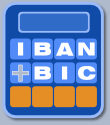IBAN Calculation
An example of how a German IBAN is calculated using an account number and bank code:
- Form a single number using the bank code, account number, and country designation. The bank code is at the beginning of the number. The 10 digit account number is appended to the bank code. Should the account number be shorter than 10 digits, zeros are added to the beginning. If any of the numerous exceptions apply, the account number might also need to be padded in some other way, or the bank code might need to be altered. Finally, the numbers 131400 are appended. These digits stand for "DE00"; Letters are changed to two digit numbers, where A is 10, B is 11, etc.
Example: Using the account number 123456789 and bank code 50010517, we get the number 500105170123456789131400. - The remainder of the 24 digit number above when divided by 97 is then subtracted from 98. Should this be a single digit, a leading zero is added. The result is two check numbers.
Example: Division of 500105170123456789131400 by 97 leaves a remainder of 57. This number is then subtracted from 98. The result in this case is 41. - Finally, the IBAN is the two letter country code, followed by the two check numbers, the bank code, and the account number.
Example: For the account number 123456789 and bank code 50010517, we get the IBAN DE41500105170123456789.
For other countries, the check digits are calculated using the same method. However, the bank codes and account numbers might be mapped to different places in the IBAN. Also, the length of the IBAN differs between countries, but it is always the same within one country.
Determining the BIC
The BIC is usually looked up in a country-specific directory. For instance, German BICs are found in the quarterly-updated directory published by the German Bundesbank.
